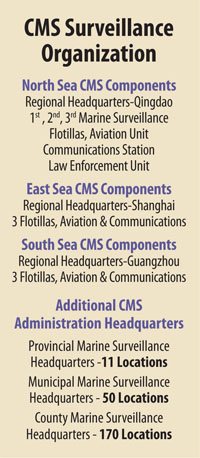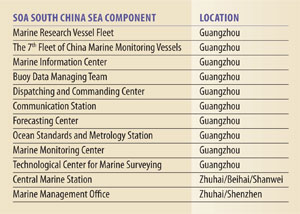Parsing China's Fourth Fleet
A host of paramilitary and civilian organizations populate this unofficial naval force.
The People’s Liberation Army Navy has at its disposal a variety of boats and ships for use in littoral waters. They are organized under separate maritime agencies that carry out specific missions officially similar to their counterparts in other countries. Yet, despite their diverse nature, these vessels together constitute an unofficial fourth fleet for the Middle Kingdom’s navy.
China has eight non-People’s Liberation Army Navy (PLAN) maritime agencies that are not part of the PLAN: the State Oceanographic Administration (SOA), the Marine Environmental Forecast Service (MEFS), the Bureau of Fisheries (BOF), the Fisheries Law Enforcement Command (FLEC), the Maritime Border Defense Force (MBDF), China Marine Surveillance (CMS), the China Coast Guard (CCG) and the Maritime Safety Administration (MSA).
Little information or analysis exists on these various paramilitary or civilian fleets that are controlled by Chinese military direction. Comprehending how they all came to be and how China can coordinate these eight different major organizations—which consist of several sub groups—can be difficult.
In 1949, the Transportation Ministry created the MSA, and the Public Security Ministry established the MBDF. In 1965, the Land/Resources Ministry created the SOA. The BOF was created under the Agriculture Ministry in 1974. The current Coast Guard was established by the Public Security Ministry in 1979. The SOA established the MEFS in 1985, followed by the CMS in 1998. This showed the SOA was a growing power in maritime protection. A new rescue and salvage group was created under the MSA in 1999. The date that the Agriculture Ministry established the FLEC, and when the trawlers were integrated formally into the navy militia, is unknown.
Consolidation of these groups could result in one North Headquarters at Qingdao instead of a split among Qingdao, Shenyang and Yantai. Combining Eastern Headquarters at Shanghai would eliminate a headquarters at Nanjing, and Guangzhou would remain the Southern Headquarters. The CCG and MSA, which currently have only 20 flotillas, or a province headquarters, could be included.
 |
The SOA, under the Ministry of Land/Resources, has jurisdiction over the entire Chinese coast from the Russian border down to the Korean border. However, the vast majority of its components are in the South China Sea area. This illustrates the importance of the Chinese South China Sea claim of control of the huge water area, along with the numerous islands and atolls claimed by China as its own. Many SOA South China Sea components are based largely in Guangzhou, which also is the PLAN South Sea Fleet Headquarters. Parallel to the PLAN military structure are the Dispatching and Command Center, which directly controls the aircraft and fleet as well as research ships on operations via the communication station.
The East and North Sea SOA organizations are similar to the South Sea group. The East Fleet SOA Headquarters is in Shanghai, and the 4th Brigade of marine monitoring vessels and the airborne brigade are dispatched out of Ningbo. The North Fleet SOA Headquarters is in Qingdao, as are the 1st Brigade of marine monitoring vessels, a marine surveillance airborne brigade and ships/aircraft-dispatching center.
The MEFS is within the SOA organization along with the environmental monitoring centers. This organization is included because of the military reconnaissance capabilities of its satellites. Other branches include ocean wave, tide, sea ice, meteorological or sea surface temperature forecasting.
MEFS assets largely are shore-based, but a Great Wall Satellite Receiving Station was established in Antarctica in 1985 and in Zhongshan in 1989. The Yellow River station in the Arctic was established in 2003. Satellite receiving stations are co-located with naval facilities at Changcheng and Hainan, and forecasting stations are at Qingdao and Guangzhou—both of which are PLAN fleet headquarters. A converted 15,000-ton cargo ship, the Jidi, supported annual logistics resupply from 1985 until 1994. The 21,000-ton icebreaker Xue Long has taken on this role from 1995 to the present.
The BOF, under the Agriculture Ministry, is headquartered in Beijing with the Qingdao, Shanghai and Guangzhou fleet groups. BOF vessels usually are involved in the high-profile instances of China aggressively interfering with operations by U.S. surveillance towed array sensor system (SURTASS) gear in the South China Sea or the Japanese Coast Guard in the Diaoyu Islands.
Until recently, the largest BOF vessels were fairly small, with the biggest at 1,000 tons. In 2009, the 2,580-ton Yuzheng 310 was launched. The next year, it left Hainan and joined with the smaller Yuzheng 201 from the East Sea BOF, and those two vessels confronted a Japanese Coast Guard cutter in the Diaoyu Islands. Those islands have been in Japanese jurisdiction waters since World War II, but they recently have been claimed by China.
The FLEC is part of the Fisheries Management Bureau, which is the only firm difference from the BOF, which is under the Agriculture Ministry. The FLEC is responsible for protecting Chinese fishing vessels and preventing illegal fishing by other nations within China’s exclusive economic zone (EEZ).
Some confusion in differentiating between BOF and FLEC bureaus may arise. They are the only fishing organizations with Yantai as their Northern Headquarters, and the vessels attached to both are all named Yuzheng. For example, reports of confrontations at sea in the South China Sea cite Yuzheng 311 (FLEC) and by the Yuzheng 310 (BOF) in the Diaoyu Islands. In November 2010, Yuzheng 310 and Yuzheng 022 confronted a Japanese Coast Guard cutter off the Daioyu Islands. Because the alleged mission of both the BOF and the FLEC is fishery protection, the name Yuzheng translates to “fish governing” in English, which is appropriate for both agencies.
Starting a trend of converting PLAN ships to FLEC, in 2008 the PLAN Fuchi-class oiler 888 was renamed Yuzheng 88. In November 2009, a 4,450-ton ex-PLAN Dalang-class submarine rescue ship, the Yuzheng 311, made its maiden voyage to enforce the May 2009 fishing ban in the disputed Paracel Island waters after completing refit in a Guangzhou shipyard. In 2011, ex-PLAN Dayun-class cargo ships and a Shengli-class coastal tanker were transferred to the FLEC as Yuzheng 21 and 22 and Yuzheng 312, respectively. They are not equipped for underway replenishment.
The MBDF, under the Public Security Ministry, is broken down into three militia groups similar to the PLAN North, East and South Sea Fleets. The MBDF groups include six military regions that consist of 10 government provinces.
Northern MBDF vessels have an “S” on their bow, for Shenyang. This points out the separation from the PLAN, which has an “S” on survey vessels. The Eastern MBDF is designated with an “N” for Nanjing. The eastern Nanjing MBDF typically is made up of assorted small PLAN vessels, and therefore many are armed. Vessels include Haiqing and Shanghai II-class patrol craft, Yulin and Yukin amphibious ships, Yukin landing craft, Youzhong cable ships, Fuzhou coastal tankers and armed trawlers.
The Guangzhou MBDF covers the southern coast, and its vessels have a “G” on their hulls. The area originally included Hainan Island, but a South China Sea Fishery Headquarters reorganization in September 1994 split Hainan and the South China Sea islands into a separate fishery administration region. That same year, the Central Military Commission began a massive restructuring and upgrading of both border and coastal defenses within the MBDF. This resulted in changing the name of the MBDF to National Border and Coastal Defense in January 2005.
 |
MBDF Border Security similarly is allegedly made up of many People’s Armed Police troops. As part of the National Bureau to Combat Desertification modernization, a nationwide digital surveillance system linking all outposts was completed in 2009. The term Marine Police frequently is used for the coast guard, and it may no longer be part of the MBDF. The current CCG is a separate element. And, the fourth component, Border Defense, consists strictly of land-based outposts that recently have been updated with a new advanced digital communication network.
The CMS is under the SOA organization and is fairly new. It was established in October 1998 for law enforcement within China’s EEZ. When China extended sovereign control to include the South China Sea, it became a vast area to cover. Although the CMS largely has been unarmed, in October 2008 it was announced that the CMS would become a reserve force for the PLAN. In December 2008, Haijian 46 and 51 vessels entered the Diaoyu Island waters. Haijian 51 escalated this operation in May 2010 when it chased a Japanese ocean survey ship Shoyo and ordered it out of China’s EEZ.
CMS surveillance units include 91 patrol vessels and four aircraft. At least three of the newer vessels carry a new B-7112 Sea Monitor helicopter designed for the CMS by Citic Offshore Helicopter Company in Shanzhen, Guangzhou. Identified larger patrol vessels all are named Haijian, which translates to “sea monitor” in English.
Although numerous coastal police and rescue forces had been in existence for decades, the official CCG was not established until 1979. It still lacks the three-fleet organization structure of other coastal paramilitary groups. It is a maritime branch of the Public Security Border Troops under the Public Security Ministry. Its MSA charter is exactly what a civilian coast guard would do. The MSA area includes the rivers and their coastline territory. The MSA structure includes search and rescue (SAR), aids to navigation, marine traffic control, marine accident investigation, law enforcement, port control, prevention of ship pollution, navigation warnings and notices, and it handles the China Ship Reporting System (CHISREP).
The CCG 20 port flotillas match the 20 MSA province branches. The assortment of CCG cutters and patrol boats all share the name Haijing, which translates to “sea police” in English. All nations of the world share the red slash on the sides of their coast guard vessels, but CCG vessels do not. The CCG has not participated in any of the aggressive actions noted primarily by FLEC, MSA, CMS and trawlers.
All the headlines about China building new 3,000- or 4,000-ton maritime protection vessels and being such a threat to Japan ignore the fact that China is decades behind the Japanese Coast Guard. Twenty years ago, Japan had 12 large helicopter-equipped coast guard cutters ranging from 3,000 to 7,000 tons. China has 11 maritime patrol vessels (MPVs) between 3,000 tons and 4,500 tons. The pace of new construction will add 11 more MPVs between 3,000 tons and 5,000 tons in the next five years.
The MSA, established in 1949 under the Ministry of Transportation, has SAR coordination in coastal waters and rivers and responsibilities similar to the CCG in other nations. MSA duties include navigation aids and warnings, sailor certification and passports, law enforcement, ship pollution prevention and accident investigation. China sent MSA Haixun 11 and CMS Haijian 83 to the North Pacific Coast Guard Forum (NPCGF) joint exercise in August 2010. Haixun 21 was the first MSA vessel to participate in Japan-China SAR exercises in 2004. Most recently, in 2009, it provided Shanghai harbor security for World Expo 2010, and it was sent for SAR aid in post-tsunami-devastated Japan in March 2011, which represented another first for China.
In 1999, following the loss of 282 lives when a ferryboat capsized in Bohai Bay, China created a new rescue and salvage organization under the MSA. The North Fleet has grown to 15 Beihaijiu rescue vessels; the East Fleet consists of 15 Donghaijiu vessels; and the South Fleet has 16 Nanhaijiu vessels. Nanhaijiu 111 rescued 97 Vietnamese fishermen in the South China Sea in May 2006. Rescue will launch four 3,000- to 5,000-ton vessels by 2014.
James C. Bussert is employed at the Naval Surface Warfare Center, Dahlgren, Virginia, where he works on surface ship antisubmarine fire control systems. The opinions expressed in this article do not necessarily reflect the views of the U.S. Defense Department or the U.S. Navy.




Comments